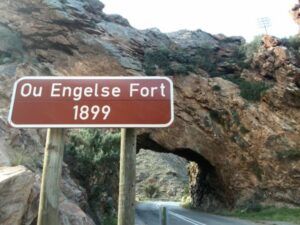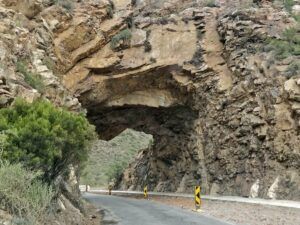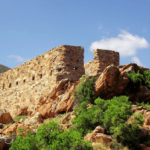Sidney fort at Cogman’s kloof
The Sidney Fort at Cogman’s Kloof is set high on a rock above the R62 road, it was constructed between 1899 and 1901. The fort was declared a national monument in 1999. It is situated on top of the tunnel in Cogmanskloof about 4km from Montagu. The building of the fort was overseen by stonemason William Robertson. The walls are 40cn thick and two meters high. A circular mortar stone platform with a drainage channel indicates that there was a water tank there. Water would have been collected from rainfall on the roof. The site had been selected by Lieutenant Colonel Sidney, Commandant of the Royal Field Artillery.
During the war, Montagu was home to four small rectangular forts and one circular fort. These forts kept Commandant Gideon Scheepers and his Boer Commando of 300 men from entering the area. The British garrisons stationed in these forts helped ensure the strategic importance of Montagu, making it a difficult target for the Boer forces.
The Gordon Highlanders under the command of Lieutenant Forbes were garrisoned at the fort after surviving the battle of Magersfontein. They camped on the original road construction site below Kalkoenkrans (Turkey Crag) the site which is now the parking area below the fort. In spite of the 21 rifle ports, the fort did not see any action. Fort Sidney is one of four built in the Montagu area. which is probably why Commandant Gideon Scheepers and the Commando of 300 avoided Montagu.

In 1999, this Old English Fort was declared a national monument – but it dates back as far as October 1899.
Cogmanskloof is a mountain that runs through the Langeberg mountains between Ashton and Montagu. It is named after a Khoi chieftain, Cogmans, who lived and ruled his tribe in the region in the 18th century. The pass was designed and built by Thomas Bain.

The tunnel is directly under the fort.


